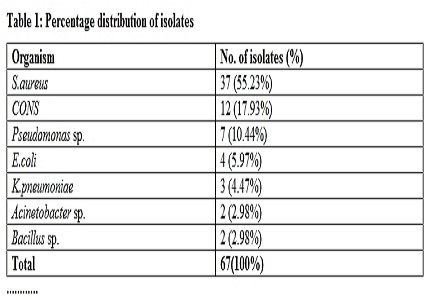Microbiological flora of cell phones: a reservoir of potential pathogens?
Abstract
Background: Hospital associated infections are a major problem in all hospital settings. The heavy use of cell phones which come in close contact with the body surfaces could act as a fomite for microorganisms and it can transmit pathogenic as well as non pathogenic microorganisms.
Objective: To determine the rate of bacterial contamination of cell phones of hospital staff and to study their antibiogram.
Methods: A cross-sectional study was conducted in a tertiary care hospital. Sterile swabs were collected from cell phone surfaces of healthcare workers (HCW). The samples were processed as per standard microbiological techniques and antimicrobial susceptibility testing was done.
Results: Out of the 100 cell phones studied, 60(60%) showed bacterial growth. 28(56%) were from doctors and 32(64%) from the paramedical staff. Staphylococcus aureus with 37(55.23%) isolates was predominant followed by CONS 12(17.93%), Pseudomonas sp. 7(10.44%), E. coli 4(5.97%) and Klebsiella pneumoniae 3(4.47%), 2(2.98%) Acinetobacter sp and Bacillus sp. 36 of HCW had cleaned their cell phones out of which 16 (44.44%) showed bacterial growth whereas 64 cell phones had never been cleaned, out of which 44 (68.75%) showed bacterial growth. Among the Gram positive isolates, Linezolid and Vancomycin were the most effective antibiotics and Imipenem and Piperacillin-Tazobactam were most effective against Gram negative isolates.
Conclusion: HCW are exposed to pathogenic microorganisms which can be easily transferred to their cell phones thus acting as a source of infection to others. Cleaning of cellphones with alcohol based disinfectants and frequent hand washing should be encouraged.
Downloads
References
Chawla K, Mukhopadhayay C, Gurung B, Bhate P, Bairy I. Bacterial ‘Cell’ Phones: Do cell phones carry potential pathogens? Online J Health Allied Scs. 2009 May; 8(1):8.
Trivedi HR, Desai KJ, Trivedi LP, Malek SS, Javdekar TB. Role of Mobile Phone in Spreading Hospital Acquired Infection: A Study in Different Group of Health Care Workers. Natl J Integ Res Med. 2011; 2(3):61- 65.
Bhat SS, Hegde SK, Salian S. Potential of Mobile Phones to Serve as a Reservoir in Spread of Nosocomial Pathogens. Online J Health Allied Scs. 2011 Jul; 10(2):14.
Pal K, Chatterjee M, Sen P, Adhya S. Contaminated Cell Phones of Health Care Personnel. National Journal of Laboratory Medicine. 2015 Oct; 4(4):33-8.http://www.njlm.net/articles/PDF/2069/8-%2013984_F(AK)_PF1(VSUAK)_PFA(AK)_PF2(PVSU).pdf.
Collee JG, Miles RS, Watt B. Tests for the identification of bacteria. In: Collee JG, Fraser AG, Marmion BP, Simmons A, editors. Mackie & McCartney Practical Medical Microbiology. 14th ed. Edinburg: Churchill Livingstone; 1996. p. 131-50.
CLSI. Performance standards for antimicrobial susceptibility testing. 20th Informational Supplement. M100-S20. Wayne, PA: Clinical and Laboratory Standards Institute; 2010.
Killic IH, Ozaslan M, Karagoz ID,Zer Y, Davutoglu V. The microbial contamination of mobile phones used by healthcare staff. Pakistan Journal of Biological Sciences. 2009; 12(2):882-4.
Datta P, Rani H, Chander J, Gupta V. Bacterial contamination of mobile phones of health care workers. Indian J Med Microbiol. 2009 Jul-Sep;27(3):279-81. doi: http://www.ijmm.org/text.asp?2009/27/3/279/53222.
Karabay O, Kocoglu E and Tahtaci M. The role of mobile phones in the spread of bacteria associated with nosocomial infections. J Infect Developing Countries. 2007; 1(1):72-3.
Ulger F, Esen S, Dilek A, Yanik K, Gunaydin M, Leblebicioglu H. Are we aware how contaminated our mobile phones with nosocomial pathogens? Ann Clin Microbiol Antimicrob. 2009 Mar 6;8:7. doi: https://doi.org/10.1186/1476-0711-8-7.
Tambe NN, Pai C. A Study of microbial flora and mrsa harboured by mobile phones of health care personnel. International Journal of Recent Trends in Science and Technology. 2012; 4(1):14-8.
Jayalakshmi J, Appalaraju B, Usha S. Cellphones as reservoirs of nosocomial pathogens. J Assoc Physicians India. 2008 May;56:388-9.
Singh S, Acharya S, Bhat M, Rao SK, Pentapati KC. Mobile phone hygiene: potential risks posed by use in the clinics of an Indian dental school. J Dent Educ. 2010 Oct;74(10):1153-8.
Pandey A, Asthana AK, Tiwari R, Kumar L, Das A, Madan M. Physician accessories: doctor, what you carry is every patient's worry? Indian J Pathol Microbiol. 2010 Oct-Dec;53(4):711-3. doi: http://www.ijpmonline.org/text.asp?2010/53/4/711/72047.
Kramer A, Schwebke I, Kampf G. How long do nosocomial pathogens persist on inanimate surfaces? A systematic review. BMC Infect Dis. 2006 Aug 16;6:130.
Nirupa S, Vignesh RNB , Jeya M. Can mobile phones act as vehicles transmitting nosocomial infections?. Int J Pharm Bio Sci. 2013; 4(1):859 -64.
Panchal CA, Kamothi MN, Mehta SJ. Bacteriological profile of cell phones of healthcare workers at tertiary care hospital. Journal of Evolution of Medical and Dental Sciences. 2012; 1(3):198-202.



 OAI - Open Archives Initiative
OAI - Open Archives Initiative


